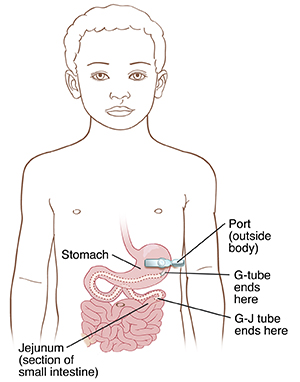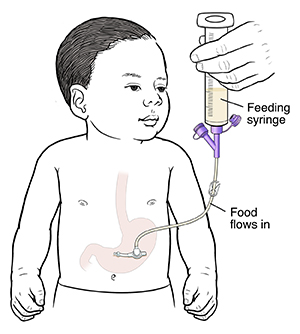Your Child's Gastrostomy or Gastro-Jejunum Tube: Syringe Feeding
Your child is going home with either a gastrostomy tube (G tube) or a gastro-jejunum tube (G-J tube) in place. A G-tube is placed through the belly (abdominal)wall into the stomach. This tube sends liquid food directly into the stomach. This sheet will help you give feedings by gravity through a syringe into the G tube.
A G-J tube is placed through the abdominal wall into the stomach and leads into part of the small intestine called the jejunum. It sends liquid food directly into the jejunum. The tube will have a capped end (port) to send liquid food, fluids, and medicine into the stomach (G-tube) and a different port that goes into the jejunum (J-tube). If your child needs a feeding directly into the jejunum through the J tube port, you'll be shown how to do so using a pump. Follow your child's healthcare team's specific instructions for pump feeding into the J tube.
 |
| The G-tube or G-J tube is placed so that liquid food or medication is delivered directly into your child’s stomach or small intestine. |
Keep in mind that there are many types of G and G-J tubes, syringes, and feeding supplies. Your child’s tube and supplies may look or work differently from what are described and shown here. One type of tube has a connection that lets you plug or push the syringe into the G or G-J tube. Another type has a twist-on safety connector. The twist-on connector means you must use a specific type of syringe that screws onto your child's G or G-J tube. Follow the instructions given by your child’s healthcare provider or home health nurse.
Note
Take care to keep the tube from becoming a strangulation risk to your child. Follow your healthcare team's advice on how to secure the tube safely.
Contact information to keep handy
Ask your child's healthcare team for phone numbers to call if you need help. Also, make sure you have the phone number for your child’s medical supply company. You’ll need to order more supplies for your child in the future. Write down all of these phone numbers below:
Healthcare provider: _____________________________________
Home health nurse: ______________________________________
Medical supply company: __________________________________
Bolus feeding
A bolus feeding is a meal-sized amount of liquid food given through the tube several times a day. Bolus feeding is given through a syringe into the G-tube leading to the stomach. . Your child’s provider or home health nurse will tell you how much liquid food to use for each feeding. You’ll also be told how often to feed your child.
For bolus feeding, fill in the numbers below:
Feed your child on this schedule: _____________________________________________
Give this much at each feeding: ______________________________________________
Feeding your child by gravity
The supplies you’ll need are:
-
Liquid food
-
Feeding syringe
-
Extension tubing

Follow these steps:
-
Wash your hands with soap and clean, running water.
-
Check the label and expiration date of the liquid food. Don’t use any can or bag of food if the expiration date has passed. Instead, get a new can or bag of food.
-
Open the feeding port cap on the G or G-J tube.
-
Connect the extension tubing to the feeding port of the G or G-J tube.
-
Not all tubes have clamps. If the tube has a clamp, make sure it is closed.
-
Pull the plunger out of the feeding syringe.
-
Connect the feeding syringe to the other end of the extension tubing.
-
Pour the liquid food into the feeding syringe. Fill only to the amount that was prescribed by your child’s provider.
-
Open the clamp on the extension tubing.
-
Hold the feeding syringe straight up. This allows the food to run through the G or G-J tube by gravity. Adjust the angle of the feeding syringe to control the flow rate of the food.
-
If the food flows too slowly or doesn’t flow at all, place the plunger in the syringe. Gently push the plunger a bit. This can help remove anything that is blocking or clogging the tube. Don't push the plunger all the way into the syringe or with force.
-
Refill the feeding syringe with food, if needed. Repeat steps until your child has received the prescribed amount of food.
-
After the feeding, flush the extension tubing with water as you were shown in the hospital.
-
Disconnect the syringe from the extension tubing.
-
Disconnect the extension tubing from the G or G-J tube.
-
Close the feeding port cap on the G or G-J tube.
Additional instructions: ______________________________________________________
_________________________________________________________________________
_________________________________________________________________________
_________________________________________________________________________
When to call the healthcare provider
Contact the provider right away if any of the following take place:
-
You see blood around the tube, in your child’s stool, or in the contents of the stomach. Depending on the amount, you may be advised to call 911.
-
The tube feels loose or comes out.
-
The opening where the tube enters the skin becomes larger.
-
Red, rough tissue forms around the tube site.
-
The tube becomes clogged or blocked and you can’t clear it.
-
The skin around the tube site has redness, swelling, leaking fluid, or sores.
-
Your child coughs, chokes, or vomits while feeding.
-
Your child’s belly looks bloated or feels hard when gently pressed.
-
Your child has diarrhea or constipation.
-
Your child has a fever 100.4°F (40°C) or higher in a child of any age or as directed by the provider.
Call 911
Call 911 if: